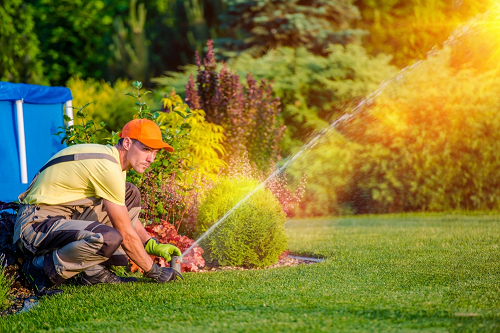Tips for the Best Sprinkler System Design
Your sprinkler system is essential for keeping your yard lush and healthy. When you invest in the best sprinkler system, you reduce your water usage and the time you spend tending your lawn. Here are some tips for the best sprinkler system layout for a hassle-free, flourishing yard.

Determine the Size of Your Yard
Knowing the size of your yard is the first step in designing your sprinkler system. The yard size determines the size of your sprinkler system, the number and types of pipes, valves, manifolds, controllers, and the number of nozzles to use. When measuring your lawn, include the driveway, walkways, outdoor sheds, and your house.
Measure the Water Pressure
Your local water authority can give you a report on your property’s water pressure. But since the pressure may vary from one point across your yard to the other, measure the water pressure and gallon per minute from different locations. Hook a water gauge to an outdoor spigot, and then turn it on fully to detect the water pressure.
Measure the gallons per minute( GPM) water flow in your property by placing a gallon under a tap and recording the time it takes to fill up with water when you turn on the tap to full blast. The water pressure and GMP determine if there will be sufficient water flow in your sprinkler system to irrigate your yard.
If the pressure is low, you may need to operate sections of the sprinkler system separately. This is not a problem since the sprinkler sections serve areas with different watering needs.
Determine Your Hydrozones
Different parts of your property have varied watering requirements based on the soil type, type of plants, and shade covering. Shady areas require less watering than the areas that receive sunlight all day.
Besides, native plants may need less water, the same way clay soil needs less water than sandy soil since it holds water better. These hydro zones will help you set different watering frequencies on your sprinkler system.
Draw Your Sprinkler System Layout
Determine the layout of your piping, nozzle heads, valves, and irrigation controller. Draw your sprinkler system design on graph paper to a scale to ensure your measurements are accurate. This will tell you the number and size of fitting you require.
Select Your Sprinkler Heads
Pick sprinkler heads from the same brand since each brand designs sprinkler heads differently. You may need different sprinkler head designs to suit your hydro zones. Here are sprinkler head designs to consider:
- Spray Heads with Rotary Nozzles
They are ideal when spraying a large area. They can consistently sprinkle water to a radius of about 13-30 feet.
- Rotors
Fix the same size of rotors in each hydro zone for consistency. The rotor head size will depend on the area and radius you want it to reach. They can deliver water to 15 feet to 50 feet radius.
- Fixed Spray
Fixed sprays reach a radius of about 6 to 18 feet, with each sprayer delivering water to the same area consistently. Arrange your fixed sprayers to ensure a subsequent sprayer begins where its predecessor ends.
- Specialty Patterns and Bubblers
These sprayers deliver water to special landscapes areas such as lawn end strips, shrubs, and trees. They can throw water as high as 15 feet and up to 5 feet radius.
- Drip Irrigation
This sprinkler system consists of many small emitters that deliver water directly to a plant. They are laid on the ground in landscape beds and ground covers.
Acquire Your Sprinkler System Parts
Buy your sprinkler system parts from the same brand to ensure they integrate well. Ensure you pick the correct sizes and types for each hydro zone. You will need pipes, nozzle heads, manifolds, irrigation controllers, and valves.
Layout Your Sprinkler System
Follow your design sketch to lay out and join the sprinkler parts for each hydro zone. You can use common valves for small nozzle heads. You can also connect several valves to one controller.
Test and Adjust
Once you have assembled your sprinkler system, test if the sprinkler system layout works as expected. Note any anomalies and rectify them.
Test if the sprinkler system delivers water concurrently to all the parts of your yard or there are parts where the water pressure is insufficient. Some parts of the sprinkler may deliver water well when operated individually if they are affected by low water pressure and GPM.
Set your controllers appropriately to meet the watering frequency needs for each hydro zone. To get the best out of your sprinkler system layout, work with lawn experts with experience in designing, laying out, and maintaining sprinkler systems.
Are you looking for a reliable landscape maintenance company to help you with your sprinkler system design? Reach out to us. We will test your water pressure and GPM to determine the best sprinkler system parts and layout.
We will also help you identify your hydro zones for the best sprinkler system layout. Contact us today to discuss your landscape maintenance project.
Tagged: lawn care, sprinkler system
You can leave a response, or trackback from your own site. Back to Top
Leave a Reply





